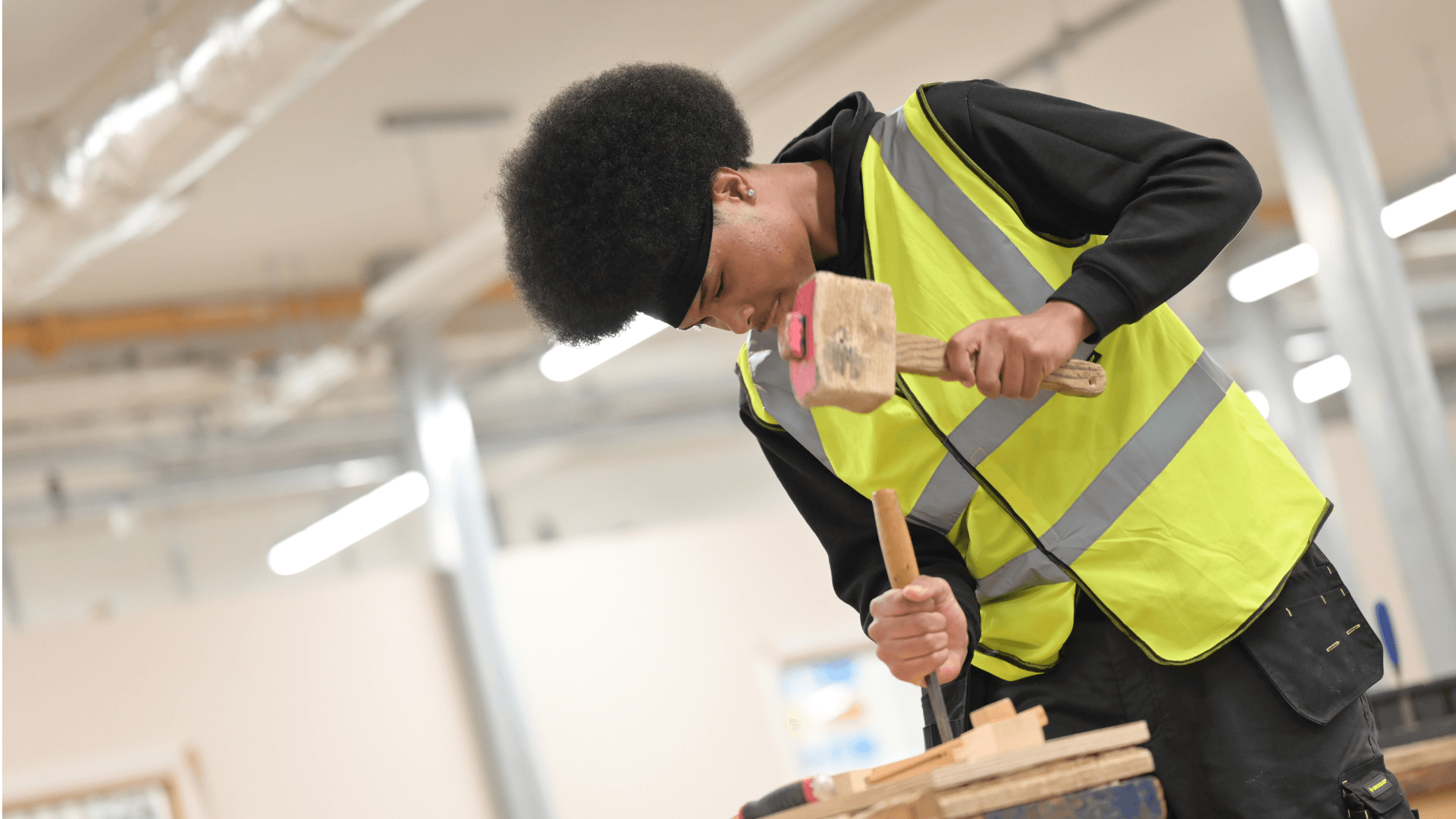

Carpentry & Joinery Apprenticeship Level 2
Course code: AP0093
Is this apprenticeship right for me?
Working as a carpenter and joiner involves carrying out skilled work, primarily using timber products, either on a construction site, or in a workshop, creating and installing building components.
This apprenticeship has two pathways with a set of core skills and competencies, as well as additional skills and knowledge pertinent to the route chosen.
Pathway 1 – Site Carpenter
A site carpenter will usually work on a building site, or in domestic and commercial premises, preparing and fixing building components, from the initial erection of a new building, through to the installation of all necessary fixtures and fittings, as well as a range of repair and maintenance activities.
Pathway 2: Architectural Joiner
An architectural joiner will usually be employed in a workshop producing timber-based building components and other architectural products, such as doors, windows, units and staircases, which are then transported to construction sites to be installed by site carpenters.
Course details
Entry Requirements:
Determined by employer
What will I learn?
CORE KNOWLEDGE, SKILLS AND BEHAVIOUR REQUIREMENTS
KNOWLEDGE (both pathways)
On completion of this apprenticeship, carpentry and joinery workers will have the following core knowledge to understand:
- Principles of health, safety and welfare and how these are applied in the workplace
- How to communicate with others and comply with instructions and directions
- Different techniques and methods used to move, handle and store materials
- How to interpret and use relevant product information and specifications
- Responsibilities under current employment and safety legislation, such as The Health & Safety at Work Act
- How to calculate quantity, length, area and wastage of resources
- Needs of other workers and how to work effectively with others
- Characteristics, quality, uses, sustainability, limitations and defects associated with timber and timber-based products and components, such as hardwood, softwood, MDF and other materials
In addition, apprentices will acquire specific knowledge for their chosen pathway to give them an understanding of:
Pathway 1 -Site Carpenter
- Technical principles of site carpentry work and how these are applied to prepare and fix timber and timber-based products, erect inclined roofs, maintain and repair building components
- How to form specific joints required for site carpentry work, such as mitres, butt and halving joints
- Why, when and how health and safety control equipment should be used when undertaking site carpentry work (e.g. personal protective equipment (PPE) and respiratory protective equipment (RPE)
- How to work safely at height and use access equipment correctly
- How to use, maintain and store hand tools, power tools and associated equipment
Pathway 2 – Architectural Joiner
- Technical principles of architectural joinery and how they are applied in routine tasks, such as, setting out and producing cutting lists, marking out from setting out details and producing cutting lists, fitting and assembling routine products
- How to accurately take site and workplace dimensions
- How to form and proportion joints associated with architectural joinery work, such as mortice and tenon, dovetail and comb joints
- Why, when and how health and safety control equipment should be used when undertaking architectural joinery work (e.g. personal protective equipment (PPE) and respiratory protective equipment (RPE)
- How to use, maintain and store marking and testing tools, hand tools, power tools and associated equipment.
- How to requisition architectural joinerymaterials, such as timber, adhesives and fixings
- How to work at height and use access equipment safely
SKILLS
On completion of this apprenticeship, carpentry and joinery workers will have developed skills to enable them to:
- Work safely and be aware of key health, safety and welfare issues
- Plan and carry out their work to commercial standards of quality and speed
- Move, handle and store resources, such as materials and timber components, complying with relevant legislation & guidance
- Interpret and follow verbal and written work instructions from trade supervisors and site managers
- Select the required materials to carry out the work, such as correct timber, tools and fixings
- Access, interpret and use drawings and specifications to carry out their work
In addition, apprentices will acquire specific occupational skills for their chosen pathway to enable them to:
Pathway 1 – Site Carpentry
- Carry out a range of job tasks including measuring, marking out, fitting, cutting, splicing, finishing, positioning and securing.
- Install door and window frames, door and hatch linings, floor joist coverings, straight partitions and straight staircases.
- Install doors, ironmongery, service encasements, wall and floor units and fitments, cladding and staircase components.
- Erect inclined roofs with gables, joists, roof coverings and roof components.
- Repair or replace frames, mouldings, doors, windows, door and window ironmongery, roofing components, guttering and downpipes and window components.
- Use, maintain and store hand tools, power tools and associated equipment
Pathway 2 – Architectural Joiner
- Carry out a range of job tasks including drawing, measuring, marking out, fitting, finishing, positioning and securing
- Produce setting out details for the manufacture of doors, windows and opening lights, units and stairs
- Mark out timber from setting out details for the manufacture of doors, windows and opening lights, units and/or fitments and staircases.
- Create, fit and assemble components to manufacture doors, windows with opening lights, units and/or fitments and staircases
- Use, maintain and store specific architectural joinery tools and equipment, such as marking and testing tools, power tools and hand tools
BEHAVIOUR
Carpentry and joinery workers will be expected to demonstrate the following behaviours:
Effective communication: oral, written, listening, body language, presentation
Effective team working: work effectively with others with limited supervision
Independent working: take responsibility for completing their own work
Logical thinking: use clear and valid reasoning when making decisions
Working effectively: undertake the work in a reliable and productive manner
Time management: use own time effectively to complete the work on schedule
Adaptability: be able to adjust to changes to work instructions
How will I be assessed?
Throughout the programme the apprentice will receive expert training from highly qualified staff.
A qualified assessor will provide an induction and regular workplace assessments.
Assessment will take place both during and at the end of the apprenticeship, with completion being dependent on successful achievement of the qualification elements and the endorsement of the employer after a professional discussion, with the apprentice and training provider.
What can I do next?
On completion of this standard, some apprentices may progress onto the Advanced Apprenticeship Standard in Carpentry and Joinery, or secure employment as a site carpenter or architectural joiner.
Can’t find any apprenticeship vacancies?
Just fill in the registration form below and we’ll let you know when more Apprenticeship vacancies become available.
Advanced Technology and Automotive Centre
You will combine working for the company with studying towards occupational standards set by employers – usually attending college one day per week – and will train in the brand new Advanced Technology and Automotive Centre at the Wellington Road campus, in Bilston.
Future careers
Whether you know what you want, or you don’t, get career inspo with our Future Finder.
At City of Wolverhampton College, we boast strong links with leading universities and over 1,000 employers – meaning our courses are all career focussed and relevant.
Like what you’ve seen?
Then it’s time to apply.
Unsure whats right for you?
Visit us at one of our Open Events and see what City of Wolverhampton College has to offer.



